A 30-year-old ash tree stands in Plymouth resident Stan Tikkanen’s backyard. While it’s been a valuable source of shade for his home for many years, it’s also the preferred source of food for the emerald ash borer (EAB) an invasive beetle that was first confirmed in the city last fall. With cases recorded in Plymouth starting this spring, the city is taking action to protect as many trees as possible and inform residents such as Tikkanen of steps they can take to save their own.
The metallic green insects are only about the size of a grain of rice, but they’re lethal to ash trees and can kill them within a few years of infestation. They were first found in Michigan in 2002 and continued to spread. The city has been expecting the arrival of EAB, especially after the insects first arrived in Saint Paul in 2009. “It wasn’t a question of ‘if,’ it was always a question of ‘when,’” city forester Paul Buck says. “So we created a plan.”
That plan got underway in 2012 when the city removed about 300 smaller public ash trees and replaced them with other species the following year. Since 2014, the city has treated about 900 trees. While all of the ash trees on public land can’t feasibly be protected, the biennial treatments are close to 100 percent effective in preventing EAB infestations.
Buck is now encouraging residents to get informed and start on a plan of action with their own ash trees if they haven’t already. “For years I’ve been saying, ‘Be prepared and have a plan.’ Well, now my story is, execute your plan,” Buck says.
The first step is to determine if you want to keep any ash trees on your property. Buck says removing smaller ash trees is advisable since you can do it yourself and replace them with other trees that won’t have the future costs of EAB prevention attached. Winter is the best time of year to remove larger ash trees since both costs and chances of a colony relocating are lower.
For those with more mature ash trees that they’d like to keep, Buck recommends pursuing professional treatment. More effective than a store-bought treatment, professionals will drill a small hole in the tree and inject pesticide every two years. Since EAB larvae live inside the bark and kill the tree by feeding, this treatment is highly effective in preventing infestation. Spring is the ideal time of year for the best distribution of the pesticide throughout the tree, although fall is also an option.
Tikkanen, who used home treatments for the past three years, decided to call in the professionals this spring after attending a seminar on EAB at City Hall last winter. He has found information from the city helpful as he weighs his options. “It’s been a very positive experience, so hopefully we can save our tree,” he says. In addition to general information on the city’s website, the city also launched an interactive EAB map that allows homeowners to look up and enter information on where ash trees are and if they’re being treated.
“We can’t let our guard down,” Buck says. EAB can be hard to detect early on since the beetles are often out of sight and take awhile to noticeably damage a tree. He expects a population explosion to run its course over the next few years, but stresses that preventation is key.
Signs of emerald ash borer
Woodpeckers: Increased woodpecker activity on your tree during winter months can be a signal of EAB since the birds like to eat the larvae.
Canopy failure: The insects damage the vascular system of the tree, preventing proper flow of water and nutrients to the top of the tree and causing a thinning, off-color canopy.
Bark splitting: Larvae tunneling underneath the bark can cause it to visibly crack.
Visit the City of Plymouth website for more information on EAB and for access to the map.









